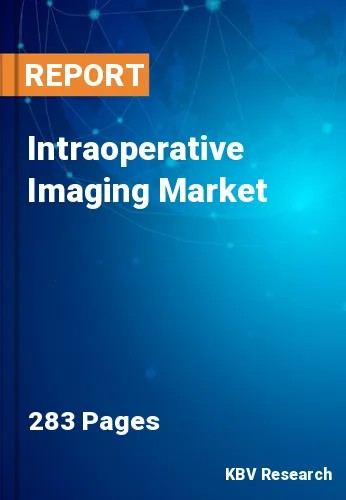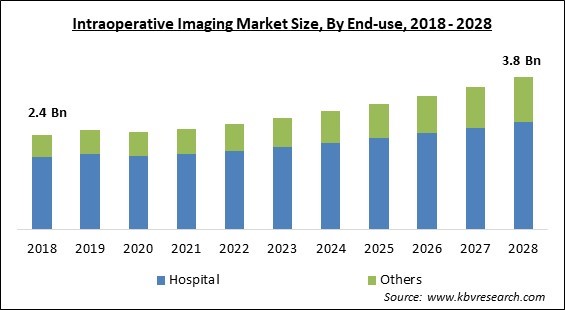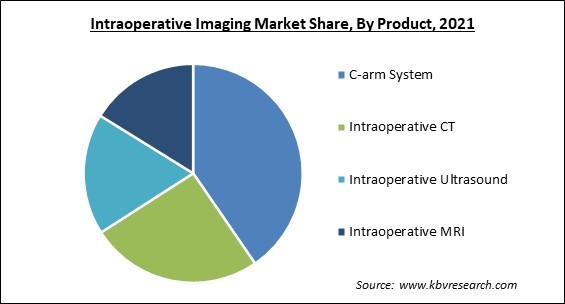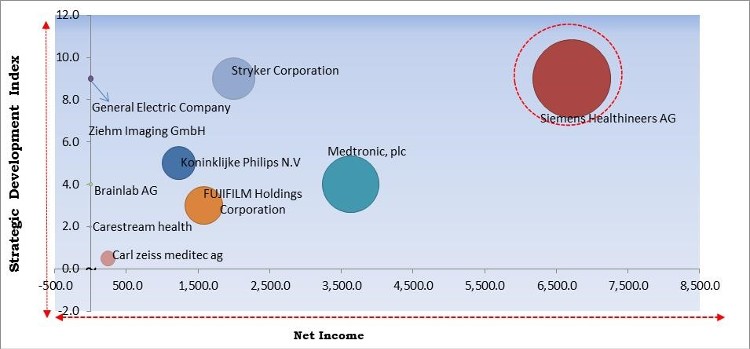
The Global Intraoperative Imaging Market size is expected to reach $3.8 billion by 2028, rising at a market growth of 6.3% CAGR during the forecast period.
During surgery, the surgeon uses the intraoperative imaging system, an optical imaging device, to obtain a fast and detailed image of the surgical site. Through the use of images of the organ, tissue, or cell that the surgeon will be operating on, intraoperative imaging assists the surgeon. Intraoperative ultrasound, intraoperative X-ray, intraoperative MRI, intraoperative CT, and mobile C-arm are a few examples of intraoperative imaging equipment.

These tools are utilized in a variety of surgical operations, including gastrointestinal surgery, heart surgery, neurosurgery, and cancer surgery. The market is growing as a result of improvements in intraoperative imaging devices and the use of these technologies in hospitals and ambulatory surgical centres for better surgical outcomes. Additionally, the government's efforts to advance the healthcare sector spur market expansion.
Increased prevalence of chronic conditions like cancer and cardiovascular illnesses results in more surgeries being performed, which fuels the intraoperative imaging market's expansion. For example, the American Society of Clinical Oncology (ASCO) reported that 25,050 persons, including 14,170 men and 10,880 women, are expected to be detected with brain and spinal cord tumours in the United States in February 2022.
The intraoperative imaging market has been severely impacted by the COVID-19 outbreak. In the manufacturing and supply chain, the market must address issues including timely product delivery to customers and inconsistent demand for the goods and services offered in the industry. A lack of qualified lab personnel to perform/study diagnostic tests, restricted operations in the majority of industries, insufficient funding for research and academic institutions, have all contributed to the decreased availability of intraoperative imaging products to customers.
Intraoperative imaging has seen considerable changes and technological breakthroughs over the past ten years in the medical device industry, including the emergence of specialized imaging technologies as well as portable/handheld/smartphone-based intraoperative imaging equipment. Comparatively to conventional imaging devices, technologically sophisticated intraoperative imaging systems provide quick performance, better image quality, simpler consoles, and easier operations.
With consequences for almost all facets of society, which include the labour and financial markets, the demand for products and services like transportation, housing, and social protection, in addition to family structures and intergenerational ties, population ageing is prepared to be one of the most massive social evolutions of the twenty-first century. Health can be impacted by physical and social settings directly or via restrictions or rewards that influence choices, opportunities, and health behaviours.
The price of and installation costs for intraoperative imaging systems are considerable, which raises the cost of the patient's procedure. This has an impact on how quickly new systems are adopted, particularly in developing nations where the majority of healthcare facilities cannot afford these technologies. When healthcare organizations invest in such expensive systems, they frequently rely on third-party payers to cover the expenses of diagnostic and therapeutic operations carried out using these systems.
Based on Product, the intraoperative imaging market is classified into Intraoperative Ultrasound, Intraoperative CT, Intraoperative MRI and C-arm System. Intraoperative Ultrasound segment acquired a significant revenue share in the intraoperative imaging market in 2021. An interactive and rapid stream of data is provided by intraoperative ultrasound (IOUS), a dynamic imaging technique, throughout surgical procedures. High-resolution images which are unaffected by air, bone, or surrounding soft tissues can be produced since the transducer is in direct touch with the organ being studied.

On the basis of End-use, the intraoperative imaging market is segmented into Hospitals and Others. Hospitals segment acquired highest revenue share in the intraoperative imaging market in 2021. This is because hospitals are increasingly implementing cutting-edge intraoperative imaging equipment to improve patient outcomes. For example, the first cerebral resection case employing a 3.0T high field intraoperative MRI equipment was done by the Xuanwu Hospital Neurosurgery Department China in April 2019, suggesting that the department has begun a new age of precision neurosurgery.
By Component, the intraoperative imaging market is fragmented into Systems, Software and Services. The systems segment recorded the largest revenue share in the intraoperative imaging market in 2021. It is due to the growing investment by governments on the adoption of various latest healthcare technologies and solutions. These systems are developed to fulfill the workflow demands of the surgical surroundings. In addition, these systems are utilized in a wide range of processes involving cranial, spine and orthopedics.
Based on application, the intraoperative imaging market is classified into Neurosurgery, Orthopedic, ENT Surgery, Oncology Surgery, Trauma surgery/ emergency room, Cardiovascular and Others. The neurosurgery segment procured the highest revenue share in the intraoperative imaging market in 2021. Outcomes from intraoperative imaging are game-changing because they let neurosurgeons perform with greater precision, reduce the requirement for extra procedures, and shield patients from infection whereas being moved in and out of the operating theatre.
| Report Attribute | Details |
|---|---|
| Market size value in 2021 | USD 2.5 Billion |
| Market size forecast in 2028 | USD 3.8 Billion |
| Base Year | 2021 |
| Historical Period | 2018 to 2020 |
| Forecast Period | 2022 to 2028 |
| Revenue Growth Rate | CAGR of 6.3% from 2022 to 2028 |
| Number of Pages | 283 |
| Number of Tables | 484 |
| Report coverage | Market Trends, Revenue Estimation and Forecast, Segmentation Analysis, Regional and Country Breakdown, Competitive Landscape, Companies Strategic Developments, Company Profiling |
| Segments covered | Component, Product, End-use, Application, Region |
| Country scope | US, Canada, Mexico, Germany, UK, France, Russia, Spain, Italy, China, Japan, India, South Korea, Singapore, Malaysia, Brazil, Argentina, UAE, Saudi Arabia, South Africa, Nigeria |
| Growth Drivers |
|
| Restraints |
|
Region-wise, the intraoperative imaging market is analyzed across North America, Europe, Asia Pacific, and LAMEA. North America emerged as the leading region in the intraoperative imaging market with the maximum revenue share in 2021. With significant adoption of intraoperative imaging technology among important end users and quite well distribution networks for manufacturers and distributors of intraoperative imaging products, North America is a mature market.
Free Valuable Insights: Global Intraoperative Imaging Market size to reach USD 3.8 Billion by 2028

The major strategies followed by the market participants are Partnerships. Based on the Analysis presented in the Cardinal matrix; Siemens Healthineers AG are the forerunners in the Intraoperative Imaging Market. Companies such as Stryker Corporation, Medtronic plc, Koninklijke Philips N.V. are some of the key innovators in Intraoperative Imaging Market.
The market research report covers the analysis of key stake holders of the market. Key companies profiled in the report include General Electric (GE) Co., Koninklijke Philips N.V., Medtronic PLC, Siemens Healthineers AG (Siemens AG), Stryker Corporation, Fujifilm Holdings Corporation, Carl Zeiss Meditec AG (Carl Zeiss AG), Brainlab AG, Carestream Health, Inc. (Onex Corporation) and Ziehm Imaging GmbH
By End-use
By Component
By Product
By Application
By Geography
The global Intraoperative Imaging Market size is expected to reach $3.8 billion by 2028.
Technological Improvements within Intraoperative Imaging Modalities are driving the market in coming years, however, Huge Cost Associated With the Intraoperative Imaging Systems restraints the growth of the market.
General Electric (GE) Co., Koninklijke Philips N.V., Medtronic PLC, Siemens Healthineers AG (Siemens AG), Stryker Corporation, Fujifilm Holdings Corporation, Carl Zeiss Meditec AG (Carl Zeiss AG), Brainlab AG, Carestream Health, Inc. (Onex Corporation) and Ziehm Imaging GmbH
The Hospital market shows high market share in Global Intraoperative Imaging Market by End-use in 2021, thereby, achieving a market value of $2.7 billion by 2028.
The C-arm System market is leading the Global Intraoperative Imaging Market by Product in 2021, thereby, achieving a market value of $1.6 billion by 2028.
The North America market dominated the Global Intraoperative Imaging Market by Region in 2021, and would continue to be a dominant market till 2028; thereby, achieving a market value of $1.4 billion by 2028.
Our team of dedicated experts can provide you with attractive expansion opportunities for your business.
